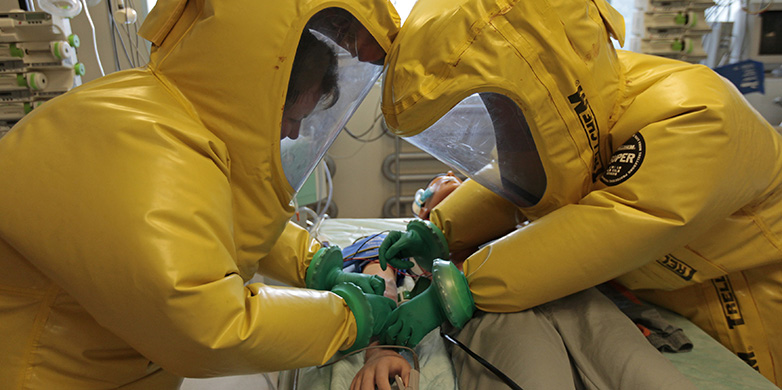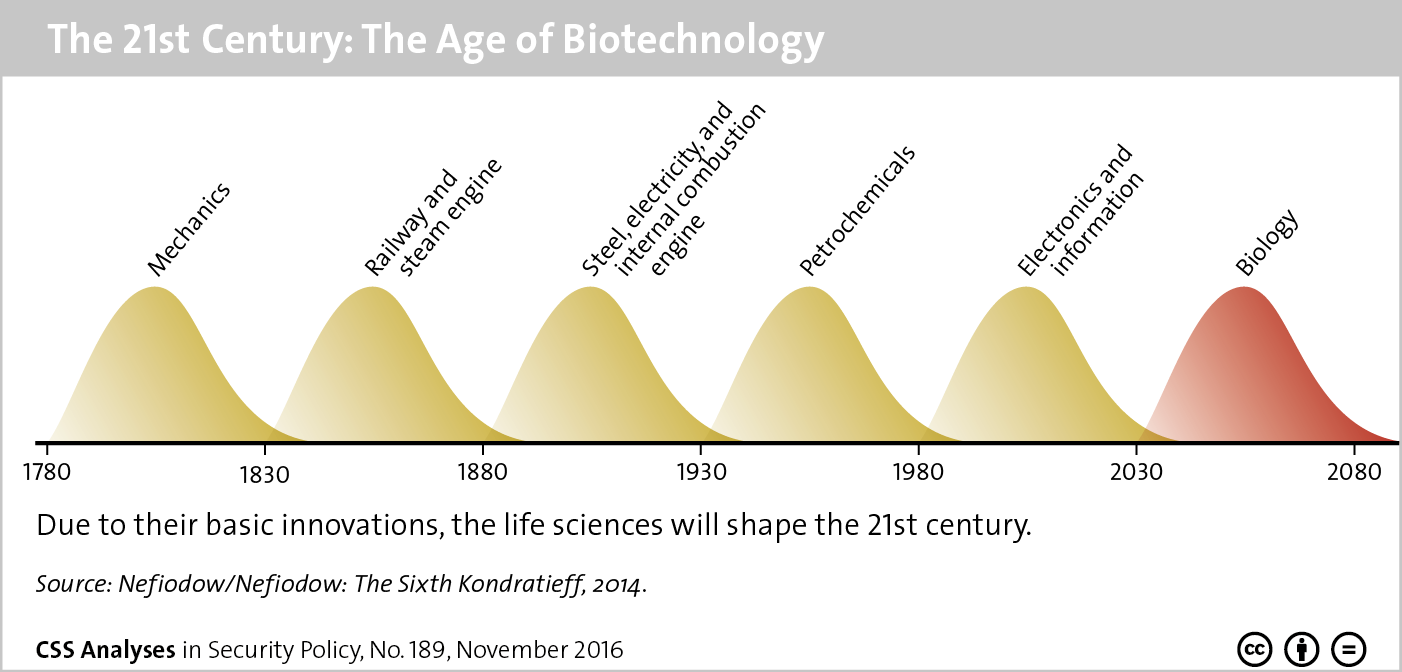Bioweapons and Scientific Advances
23 Oct 2017
By Claudia Otto and Oliver Thränert for Center for Security Studies (CSS)
This CSS Analyses in Security Policy (No. 198) was originally published in November 2016 by the Center for Security Studies (CSS). It is also available in German and French.
The states parties to the Bioweapons Convention will meet for the Eighth Review Conference in Geneva from 7 to 25 November 2016. They face the challenge of upholding the treaty’s relevance in the face of radical technical and scientific advances in the life sciences.
The Biological Weapons Convention (BWC) of 1975 is the oldest treaty banning an entire category of weapons of mass destruction. However, the treaty does not stipulate any effective verification measures, nor is there any dedicated organization with responsibility for the implementation of the bioweapons ban.
Infectious organisms of all kinds as well as viruses can be used as biological agents that cause illness or death among humans, animals, or plants. Moreover, bioweapon agents include toxins, or biologically derived poisons, that may, for instance, be produced by fungi or bacteria.
Today, the proliferation of biological weapons by state or non-state actors is broadly seen as a growing threat. However, it is quite difficult to find conclusive proof of the existence of a bioweapons program. Many of the “ingredients” can either be put to peaceful or military or hostile use: so-called dual-use technologies. Most of these organisms and technologies are freely available on the market, national and international export controls notwithstanding. Moreover, the technical-scientific environment is shifting dramatically. Advances in gene sequencing, genetic manipulation, and synthetic biology have made it possible to create modified organisms. The states parties to the BWC thus face the difficult challenge of adapting the bioweapons ban to this rapidly changing environment.
The BWC and its Implementation
On the 25th of November 1969, then-US president Richard Nixon announced that his administration was forgoing its offensive bioweapons program. Although bio-weapons played no role in the Vietnam War, Nixon hoped that this unilateral move would help counteract growing domestic criticism over the use of defoliants such as Agent Orange during the conflict. The Soviet Union responded positively to the US initiative, since it was generally interested in détente. However, the Soviet Union was not prepared to allow for any on-site inspection regime. The BWC was signed on 10 April 1972 and entered into force on 26 March 1975.
The states parties to the BWC (currently 175 in total) undertake never to produce biological agents or toxins, except in ways and quantities that are warranted for prevention, protection, or other peaceful purposes. This intentionally vague “general purpose criterion” is designed to exclude all forms of biological warfare. Furthermore, the convention bans weapons, equipment, and other resources for the use of biological agents and toxins for hostile purposes or in an armed conflict. The states parties to the BWC may not transfer agents or equipment prohibited under the treaty to other states or non-state actors, and must enforce the bioweapons ban on their territory. In case of a suspected treaty violation, the member states may consult or call upon the UN Security Council for clarification. Finally, the signatory states are called upon to promote the fullest possible exchange of equipment, materials, and scientific and technological information for the peaceful use of bacteriological agents and toxins (Art. X).
Since the entry into force of the BWC, there have been repeated violations of its rules. In the 1970s, the Soviet Union massively expanded its existing offensive bio-weapons program. A research conglomerate of more than 30 institutions produced and weaponized large quantities of bio-agents, including smallpox and the Marburg virus. These were tested under real-world conditions on an island in the Aral Sea. After the demise of the Soviet Union, a trilateral process was initiated between the three BWC depositary powers – the US, the UK, and Russia – to investigate this matter. However, the enquiry was quietly terminated in the mid-1990s without tangible results, having ultimately failed to shed full light on the Soviet bioweapons program.
Another case was that of Iraq in the 1980s, when Saddam Hussein ordered the production of pathogens and toxins for military purposes. During South Africa’s Apartheid regime a bioweapons program was maintained, but the exact extent of the program remains unclear to this day. More recently, it has transpired that Syria produced the toxin ricin.
Terrorists, too, have been involved with biological agents. In the mid-1990s, the Japanese Aum Shinrikyo sect experimented with anthrax and botulinum toxin, but failed to produce deployable weapons agents. In September and October 2001, letters containing finely milled anthrax spores were sent to two US senators and several US journalists. These letters resulted in 22 anthrax infections and five deaths, but the case was never officially solved. The terrorist organization al-Qaida developed an interest in ricin and anthrax, but failed in its efforts to recruit scientists from the former Soviet weapons program.
Efforts to Enhance the Treaty
Compliance with the ban on biological weapons is difficult to verify. Bacteria and viruses can be cultivated swiftly, and many occur naturally. In order to establish increased transparency, the parties to the BWC agreed at the Second Review Conference in 1986 to introduce confidence-building measures (CBM), which were augmented at the Third Review Conference in 1991 and slightly modified at the Seventh Review Conference in 2011. These measures require, inter alia, annual reporting about activities at high biosafety level laboratories (BSL-3 and BSL-4), the exchange of information on biodefense programs, documentation on national legislation for the implementation of the BWC, and reporting of human vaccine production facilities. These CBM are politically, but not legally binding. More than half of the signatory states do not participate in them at all, and the quality of the submitted reports varies considerably.
A three-person BWC Implementation Support Unit (ISU) was established in Geneva in 2006. It serves as the secretariat of the states parties to the treaty. The ISU also collects the CBM reports and ensures the exchange of information.
In January 1995, the BWC signatory states began negotiations on a legally binding additional protocol designed to strengthen all aspects of the BWC, especially verification. In March 2001, a draft protocol was tabled requiring verification of compliance with the BWC based on annual national reports about biodefense programs, vaccine production facilities, BSL-3 and BSL-4 laboratories, and installations with high production capabilities by way of voluntary visits, transparency visits, and clarification visits. Furthermore, there was to be the possibility of challenge inspections. An international BWC organization, which had yet to be created, was to ensure implementation.
The US opposed this draft. Washington claimed that the BWC was, in the final analysis, unverifiable, and that too much transparency would increase US soldiers’ vulnerability to biological attacks. Moreover, the US feared that visits could give rise to espionage against the pharmaceutical industry. Other countries such as Russia and China, too, were uncomfortable with the additional protocol’s efforts to establish transparency. In order to avoid a complete termination of the multilateral process to strengthen the BWC, European and other Western countries advocated a substitute program that would take into account the US interests. On the occasion of the Fifth Review Conference (aborted in 2001 due to the dispute over the additional protocol, but resumed in 2002), the states parties to the treaty agreed to hold annual expert and states parties meetings on the following topics: National measures to implement the BWC, including national legislation; national measures to enhance safety in handling pathogenic microorganisms and toxins; improvements to international response capabilities in case of intentional deployment of biological weapons and outbreaks of diseases; strengthening of national and international efforts to identify and combat infectious diseases; and codes of conduct for scientists.
Since 2003, these meetings have been held in the framework of the “Intersessional Process”. In the meantime the spectrum of topics has been slightly modified and expanded: now also including matters of bio-safety and biosecurity, assistance in case of an attack using bioweapons, implementation of Article X (use of biological agents and toxins for peaceful purposes), and potential improvements of CBM. Furthermore, since 2011, there has been a stronger focus on matters related to scientific-technical advances. The meetings have enhanced transparency and fostered information exchange, especially since they were attended not only by international organizations like the World Health Organization (WHO), but also by representatives from industry and the NGO community. Even so, a number of observers believe that the discussion process has been exhausted, since many topics and contributions have been dealt with repeatedly. Attempts to better structure the discussions by introducing working groups have so far failed.
The Scientific Setting
Since the 1990s, technological advances in the life sciences have attracted a great deal of attention. They are mainly driven by the increasing convergence in the natural sciences, especially biology and chemistry. The notion of “convergence” refers to the increasing proximity, both at the level of theoretical knowledge and in terms of experimental technologies, between these disciplines, which previously were relatively distinct. This can be seen, for example, in the way certain chemicals or biological molecules can be produced and deployed. Using biocatalytic or biotechnological processes and methods in synthetic biology, synthetic pathways and production times can be decisively simplified, shortened, and designed for greater economic and ecological expediency.
For instance, these may result in fast and simplified manufacturing processes for bio-molecules (DNA, RNA, proteins), which are used in the CRISPR/Cas9 technology (CRISPR: Clustered Regularly Interspaced Short Palindromic Repeats), for example. Based on the discovery of bacterial immune defense, CRISPR/Cas9 has become an established method for targeted genetic manipulation. Using this technology, it is now possible to generate changes in the genetic makeup of humans, animals, plants, and microorganisms in a quick and targeted manner. Modifications of the genome, which took months or years using conventional genetic engineering, can now be done within just a few weeks. It is expected that with the help of CRISPR/Cas9, huge breakthroughs will be achieved in the research and therapy of hereditary diseases in humans. The new technology can also help optimize agriculture. Crop yields can be boosted and the impacts of plant diseases minimized. Also, bacteria in their natural state can be modified for the production of therapeutic proteins, such as insulin, or for the elimination of environmental pollutants.
The convergence of biology and chemistry also facilitates advances in the production of toxins. These are biologically derived substances that, even in small doses, can inhibit essential cellular processes in organisms. Use of these substances is especially prevalent in medicine, agriculture, and the cosmetic industry. Traditional production techniques were based on enrichment and isolation methods. Now, there are procedures for manufacturing large quantities of toxins using synthetic biology and biotechnology.
One example is the synthesis of toxins by the bacterium Clostridium botulinum. These bacteria exist worldwide and, as spore-producing organisms, can survive even under the most restrictive environmental conditions. They are feared for their ability to cause fatal food poisoning. Among the neurotoxic proteins that they produce – the botulinum toxins – are some of the most potent naturally occurring poisons. Their effects are based on targeted paralysis of the muscle apparatus. For this reason, Botulinum toxin A has been employed since the 1980s as a therapeutic medicine. Since 1992, it has become well-known through its use in the cosmetic industry under the labels of “Botox” or BTX-A. Today, under the control of strict safety and security regulations, Botulinum toxin is obtained from bacterial cultures on an industrial scale.
Switzerland’s Role in the BWC
Switzerland has promoted the issue of scientific and technical progress with respect to the BWC (Science and Technology Review) and will facilitate proceedings in this area at the 8th BWC Review Conference. Furthermore, since 2014, Switzerland has hosted the biennial “Spiez Convergence” conference, at which the latest scientific advances and their implications for the BWC are analyzed.
Together with friendly states, Switzerland has lobbied for the enhanced implementation of the treaty’s provisions. Among other things, this involves national legislation, laboratory safety, and the expansion of the CBM. Switzerland has regularly taken part in the CBM and made its reports publicly available.
Switzerland has also invited all states parties to the BWC for transparency visits to the Spiez Laboratory, the country’s institute for NBC safety. So far, there have been four such visits.
In 2014, Switzerland chaired the “Intersessional Process”. As such, it coordinated the expert and state-level meetings and was responsible for writing the final report for that year.
Moreover, Switzerland has supported Iraq as part of a bilateral cooperation with regard to national legislation and laboratory safety.
However, it has also appeared repeatedly in the bioweapons programs of several states, for instance in Iraq. More recently, non-state terrorist actors have also shown an interest in the toxin. Using novel technologies, it would be possible to streamline the production of the toxin.
However, the rapid advances in the life sciences are not inherently geared towards peaceful use, but may also be misused for military purposes. For instance, pathogens can be made more infectious or mutated in such a way as to make diagnosis more difficult or to degrade the effects of counter-measures such as vaccines. Strengthening the implementation of the BWC is thus an urgent priority.
The 2016 Review Conference
The Eighth BWC Review Conference, to be held from 7 to 25 November 2016 in Geneva, is a welcome opportunity for advancing this process. These conferences, held every five years, are designed to review and make proposals for improving the implementation of the agreement. Notably, however, the final documents, which are agreed by consensus, are only politically, not legally binding.
Currently, the outlook is not very favorable. In November 2016, the US will be in transition between two administrations. The outgoing administration of President Barack Obama can hardly be expected to make important contributions. Washington has voiced dissatisfaction with the “Intersessional Process” as it has evolved to date, and is calling for stronger review of the BWC’s scientific-technical framework. However, the US is opposed to any legally binding measures, such as an additional protocol.
Within the EU, only few member states are interested in the BWC. The EU continues to regard verification as a core element of effective disarmament and non-proliferation. Moreover, it believes in the importance of permanent review of the scientific-technical framework, as far as it pertains to the BWC, and advocates a universalization of the BWC. The EU also supports a voluntary peer-review process concerning the implementation of the BWC standards. Individual states such as France and Germany support this concern through various transparency measures, including by inviting states parties to the treaty to visit bio-defense installations.
Many states parties that are members of the Non-Aligned Movement (NAM), including numerous developing countries, reject what they regard as discriminatory export controls imposed by the industrialized countries. Since the benign potential of the life sciences should remain open to all, the NAM group insists on a non-discriminatory implementation of the BWC’s Article X. At the same time, some voices in this group, such as Iran and Cuba, have suggested resuming negotiations on an additional protocol. Conversely, many NAM states reject low-level efforts for incremental improvements favored by the Western states, such as strengthening CBM.
Formally, the mandate for negotiations on an additional protocol to the BWC remains intact. With reference to this option, Russia – supported by China and others – favors discussions on legally binding efforts to strengthen the BWC. Otherwise, the argument goes, the BWC will be in for a rough ride, considering the rapid change in the scientific environment.
Against this background, it would already be a success if the Eighth BWC Review Conference were to achieve progress in the following areas: First of all, the “Intersessional Process” could be reinvigorated by introducing working groups that could table concrete results. These could deal with the following topics, among others: implementation of the BWC, including national legislation and penalties for violations of the BWC, which would also apply to the illegal transfer of biological agents; scientific and technical advances and their significance for the BWC; improved implementation of Article X of the BWC, i.e., better scientific-technical exchange for peaceful purposes; and strengthening the CBM. Secondly, the mandate and capabilities of the ISU could be continued and strengthened in light of the above. And third, measures could be taken to broaden BWC membership.
Even if the Eighth BWC Review Conference were to bring forth such a reassuring outcome, diplomacy will have the long-term task of adapting the bioweapons ban to advances in the scientific-technical landscape, which some might also be tempted to abuse for military purposes, despite the huge potential for peaceful applications.
Previous issues:
Brexit: Implications for the EU’s Energy and Climate Policy No. 197
Swiss Border Guard and Police: Trained for an “Emergency”? No. 196
One Belt, One Road: China’s Vision of “Connectivity” No. 195
Why Security Sector Reform has to be Negotiated No. 194
Libya – in the Eye of the Storm No. 193
Transatlantic Energy Security: On Different Pathways? No. 192
About the Authors
Dr Claudia Otto is a Senior Researcher at the Center for Security Studies (CSS) at ETH Zurich. Her research focuses on the analysis of current trends in basic research at the interface of Chemistry and Life Sciences with dual-use potential.
Dr Oliver Thränert is Head of Think Tank at the CSS. He is the author of numerous publications including Entrenched Positions on Nuclear Non-Proliferation (2015).
For more information on issues and events that shape our world, please visit the CSS Blog Network or browse our Digital Library.



